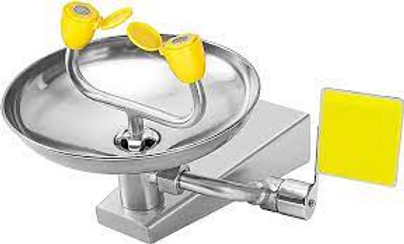EYEWASHES AND EMERGENCY SHOWERS
 The National Institute for Occupational Safety and Health (NIOSH) estimates that about 2,000 U.S. workers sustain job-related eye injuries requiring medical treatment each day. While many of these injuries are caused by small particles striking or abrading the eye, many are also caused by exposure to hazardous chemicals. Emergency eyewash and shower units play a significant role in minimizing the severity of eye injuries resulting from exposure to hazardous chemicals.
The National Institute for Occupational Safety and Health (NIOSH) estimates that about 2,000 U.S. workers sustain job-related eye injuries requiring medical treatment each day. While many of these injuries are caused by small particles striking or abrading the eye, many are also caused by exposure to hazardous chemicals. Emergency eyewash and shower units play a significant role in minimizing the severity of eye injuries resulting from exposure to hazardous chemicals.
OSHA and ANSI Requirements
In the United States, the Occupational Safety and Health Administration (OSHA) requires that “where the eyes or body of any person may be exposed to injurious corrosive materials, suitable facilities for quick drenching or flushing of the eyes and body shall be provided within the work area for immediate emergency use.” The American National Standards Institute (ANSI) similarly requires that employers provide eyewash and shower equipment where employees are exposed to hazardous materials. It is up to the employer to determine their level of exposure and the need for emergency equipment such as an eyewash or emergency shower.
Emergency Eyewash stations and showers are either connected to a continual source of potable water or self-contained, gravity fed units. Self-contained units contain their own flushing fluid that must be refilled or replaced after use. According to ANSI, emergency eyewashes and showers must be located in an area that requires no more than 10 walking seconds to reach or within 55 feet of the hazard, located in a well-lit area identified with a sign, located on the same level as the hazard, and equipped with enough tepid water for 15 minutes of continuous use. If shut off valves are installed in the unit’s supply line for maintenance purposes, provisions must be made to prevent unauthorized shut-off.
Accessibility
It is important that emergency showers and eyewash units are accessible. Obstacles in the travel path can delay response time. Seconds count when the eyes and skin are exposed to corrosive or caustic liquids or other hazardous materials. Some hazardous chemicals take only 6 to 8 seconds to penetrate the outer membrane of the eye. For skin exposure, a worker might have between 10 to 15 seconds before severe damage occurs.
Inspection
Emergency eyewash and shower units must be inspected and tested on a routine basis. Without regular maintenance, inspection and testing, the water required to flush a worker’s body or eyes could become contaminated with particulates or chemicals or fail to function all together. When inspecting emergency eyewash and shower units, the inspector should make sure the unit is accessible and the unit’s sign is visible. The unit’s water source must be turned on and the water flow must be adequate, clear. The unit must remain on until the unit is turned off. The water should also be tepid. Tepid is considered as a temperature between 60- and 100-degrees Fahrenheit (16-38 degrees Celsius). Temperatures higher than 100 degrees Fahrenheit can enhance a hazardous chemical’s interaction with both the skin and eyes.
Educating Employees
Employees must have a good understanding of emergency eyewash and shower use. This can be achieved with a simple five-minute discussion and demonstration. When using an eyewash station or emergency shower the process involves:
- Pushing or pulling the handle to activate the water flow.
- Removing contact lenses and clothing if applicable. Contact lenses can trap hazardous chemicals in the eyes and prevent the eyewash from washing out the hazardous chemical. Similarly, clothing can trap hazardous chemicals close to the skin. The eyes will naturally want to close. Holding the eyes open will allow adequate flushing.
- Flushing the eyes and skin for at least 15 minutes.
- Seeking further medical attention.
It is also important for workers to understand how to respond when another employee’s eyes or skin are exposed to hazardous chemicals. In the event of an emergency, coworkers should help the exposed worker get to the eyewash or shower and turn it on. Help the exposed worker hold their eyes open, remove contaminated clothing, and call for medical assistance. While it can seem like an eternity, they must make sure to flush the eyes and skin for at least 15 minutes. In the event that emergency services are called, noting the chemical’s name, and providing the appropriate safety data sheet is helpful for those administering treatment.
Conclusion
Emergency equipment such as eyewashes and showers are no substitute for safe work procedures and personal protective equipment. However, should the unthinkable happen, properly maintained equipment can minimize injuries resulting from chemical exposure. Remember, safety doesn’t have to be difficult. Simple steps such as inspecting and maintaining emergency eyewashes and showers, can prevent serious injuries.
Related Links:
- Root Cause Analysis: The Five Why’s
- Commitment vs Compliance
- Full Course Catalog – Safety Made Simple
References:
- EHS Today “Protecting Those Peepers: A Guide to Eye Wash and Emergency Shower Stations”
- Paul Lawton, “What Workers Need to Know About Eyewashes and Safety Showers” March 25,2014
- EHS Today “A Logical Approach to Emergency Shower and Eyewash Choices” www.ehstoday.com/print/content/21915183
Joe Mlynek is a partner and subject matter expert at Safety Made Simple, LLC. He has over 25 years of experience in safety at the corporate level and as a consultant. He is a Certified Safety Professional (CSP) and Occupational Safety and Health Technician (OHST). Joe can be reached at joe.mlynek@safetymadesimple.com
